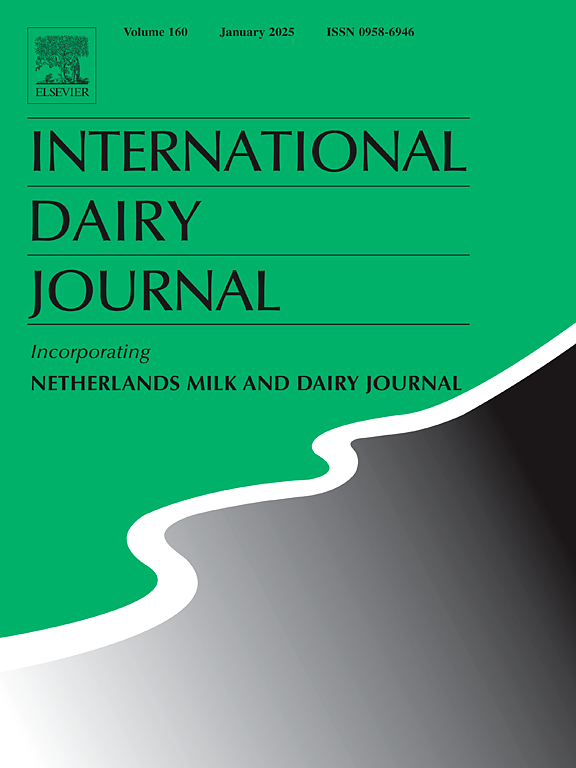Effect of processing and cream quality on protein profile and rheological properties of set and stirred sour cream
IF 3.4
3区 农林科学
Q2 FOOD SCIENCE & TECHNOLOGY
引用次数: 0
Abstract
This study aimed to investigate the effect of the growth of psychrotrophic bacteria in cream and different processing parameters on sour cream quality. Fresh cream was incubated with a proteolytic strain of Pseudomonas trivialis and incubated for 0 and 6 days at refrigerated temperature before production of sour cream. Two types of sour cream (set and stirred) with 35 % fat were produced. The set-type sour cream was produced using two-stage homogenisation (50 bar/30 bar) and two incubation temperatures (21 and 25 °C), while the stirred-type sour cream was produced using one- or two-stage homogenisation (50 bar and 50/30 bar, respectively) and only one incubation temperature (23 °C). Protein profiles, free amino acids, viscosity, and gel structure were analysed. An increase in incubation time of approximately 3 h for both types of sour cream, as well as an effect on the free amino acid and protein profiles, was detected for the products made from low-quality cream. Low-quality cream significantly affected the viscosity in the set-type but not in the stirred-type sour cream, while the two-stage homogenisation impacted the viscosity in the stirred-type sour cream. The gel structure was significantly impacted when low-quality cream was used, and changes in aggregates were observed when a higher incubation temperature and two-stage homogenisation were used. The results presented here indicate that high-quality raw material is essential for the quality of the final product. However, we also showed that adjusting the processing could overcome the quality issue originating from low-quality raw milk.
加工工艺和奶油品质对定型和搅拌酸奶油蛋白质形态和流变性能的影响
本研究旨在探讨乳膏中嗜冷细菌的生长及不同工艺参数对酸奶油品质的影响。鲜奶油与微小假单胞菌蛋白水解菌株孵育,在冷藏温度下孵育0和6天,然后生产酸奶油。生产了两种脂肪含量为35%的酸奶油(定型和搅拌)。固定型酸奶油采用两段均质(50 bar/30 bar)和两种孵育温度(21和25℃)生产,而搅拌型酸奶油采用一段或两段均质(分别为50 bar和50/30 bar)和一种孵育温度(23℃)生产。分析了蛋白质谱、游离氨基酸、粘度和凝胶结构。检测到由低质量奶油制成的产品,两种类型的酸奶油的培养时间都增加了约3小时,并且对游离氨基酸和蛋白质谱产生了影响。低质量奶油对固定型酸奶油的粘度有显著影响,而对搅拌型酸奶油的粘度无显著影响,而两段均质对搅拌型酸奶油的粘度有显著影响。当使用低质量的乳膏时,凝胶结构受到显著影响,当使用较高的孵育温度和两阶段均质化时,可以观察到聚集体的变化。结果表明,高质量的原料对最终产品的质量至关重要。然而,我们也发现调整加工工艺可以克服低质量原料奶的质量问题。
本文章由计算机程序翻译,如有差异,请以英文原文为准。
求助全文
约1分钟内获得全文
求助全文
来源期刊

International Dairy Journal
工程技术-食品科技
CiteScore
6.50
自引率
9.70%
发文量
200
审稿时长
49 days
期刊介绍:
The International Dairy Journal publishes significant advancements in dairy science and technology in the form of research articles and critical reviews that are of relevance to the broader international dairy community. Within this scope, research on the science and technology of milk and dairy products and the nutritional and health aspects of dairy foods are included; the journal pays particular attention to applied research and its interface with the dairy industry.
The journal''s coverage includes the following, where directly applicable to dairy science and technology:
• Chemistry and physico-chemical properties of milk constituents
• Microbiology, food safety, enzymology, biotechnology
• Processing and engineering
• Emulsion science, food structure, and texture
• Raw material quality and effect on relevant products
• Flavour and off-flavour development
• Technological functionality and applications of dairy ingredients
• Sensory and consumer sciences
• Nutrition and substantiation of human health implications of milk components or dairy products
International Dairy Journal does not publish papers related to milk production, animal health and other aspects of on-farm milk production unless there is a clear relationship to dairy technology, human health or final product quality.
 求助内容:
求助内容: 应助结果提醒方式:
应助结果提醒方式:


